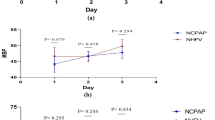Summary
The neonate with circulatory failure and cardiogenic shock is a difficult management problem. However, the initial approach is that of resuscitation with exact diagnosis of secondary concern. Once the infant has been stabilized and septic and hypovolemic shock have been excluded, attention should be directed to the four most likely causes of cardiogenic shock: structural heart disease with left heart obstruction being the most common, cardiac muscle disorders, cardiac dysrhythmias, and cardiac metabolic disorders.
Similar content being viewed by others
References
Perkins RM et al. Shock in the pediatric patient, Part II Therapy.J Pediatr 1982; 101: 319–324.
Kaplan SL et al. Endotoxic shock in children. In: Dickermon JD, Lucey JJF, eds.The Critically Ill Child. Diagnosis and Medical Management. Philadelphia: W.B. Saunders Co 1985.
Neches WH, Mathews RA, Park SC et al. Anomalous origin of the left coronary artery from the pulmonary artery: A new method of surgical repair.Circulation 1974; 50: 582–589.
Takevchi S, Imamura H et al. New surgical method for repair of anomalous left coronary artery from the pulmonary artery.J Thorac Cardiovasc Surg 1979; 78: 7–14.
Wather FJ, Siassi B et al. Cardiac output in newborn infants with transient myocardial dysfunction.J Pediatr 1985; 107: 781–785.
Nelson RM et al. Serum creatine phosphokinase M.B. fraction in new-borns with transient tricuspid insufficiency.N Engl J Med 1978; 298: 146–151.
Friedman WF. The intrinsic physiologic properties of the developing heart.Prog Cardiovascular Dis 1972; 15: 87–93.
Butt W et al. Clinical experience with systemic vasodilation therapy in the newborn infant.Aust Pediatric J 1986; 22 117–121.
Cabal LA et al. Cardiogenic shock associated with perinatal asphyxia in preterm infants.J Pediatr 1980; 96: 705–711.
Leitner M, DiSessa T et al. Hemodynamic effects of dopamine in neonatal asphyxia. Abstract.Circulation 1980; 62: iii-25.
Kilbourne ED, Wilson CB. The induction of gross myocardial lesions via coxsackie virus and cortisone.J Clin Invest 1956; 35: 362–370.
Hosenpud JD et al. Lack of objective improvement in ventricular systolic function in patients with myocarditis treated with azathioprine and prednisone.J Am Coll Cardiol 1985; 6: 797–784.
Author information
Authors and Affiliations
Rights and permissions
About this article
Cite this article
Albrecht, G.T. Cardiogenic shock in the neonate. Indian J Pediatr 60, 381–391 (1993). https://doi.org/10.1007/BF02751199
Issue Date:
DOI: https://doi.org/10.1007/BF02751199




